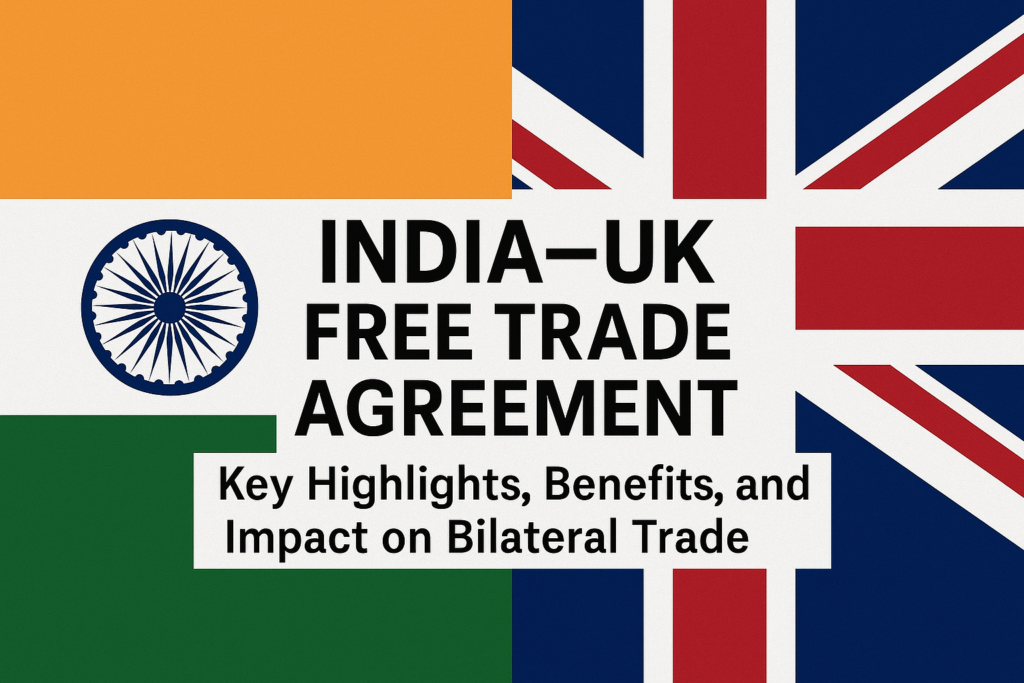
The much-anticipated India-UK Free Trade Agreement (FTA) has officially been signed on July 24, 2025, marking a new era of economic cooperation between the two nations. After over three years of rigorous negotiations and 14 rounds of talks, Prime Ministers Narendra Modi and Keir Starmer finalized the deal that promises to revolutionize trade, investment, and mobility between India and the United Kingdom
Key Highlights of the India-UK FTA
Tariff Reductions and Market Access
- India will cut tariffs on 90% of UK export lines, with immediate benefits on items like whisky, gin, luxury cars, medical equipment, and aerospace components
- UK will remove duties on 99% of Indian exports, providing a significant boost for Indian sectors like textiles, apparel, gems & jewelry, footwear, toys, and engineering goods
- The tariff on Scotch whisky, which currently stands at 150%, will be reduced to 75% immediately and further cut to 40% over the next decade.
Boost to Bilateral Trade
- The agreement is projected to increase bilateral trade by £25.5 billion (approx. $34 billion) annually by 2040.
- UK’s GDP is expected to gain £4.8 billion annually once the deal is fully implemented.
Opportunities for Professionals
- The FTA includes provisions for easier visa and mobility access for Indian professionals, including IT experts, chefs, musicians, and yoga instructors.
- A three-year exemption from UK national insurance contributions will benefit nearly 75,000 Indian workers, reducing financial burdens for both employees and companies
Access to Public Procurement
- UK companies will gain access to Indian government procurement tenders worth nearly £38 billion annually, opening new avenues in healthcare, infrastructure, and clean energy sectors.
Intellectual Property & Standards
- Strengthened IP rights, copyright protection (minimum 60 years), and improved consumer and labor standards form part of the agreement
- Custom rules and processes are being streamlined for faster trade flow.

Expected Economic Impact
The India-UK FTA is being hailed as a landmark deal, with both nations targeting $120 billion in trade by 2030. For India, the FTA offers easier access to one of the world’s largest consumer markets, while the UK gets a gateway into India’s fast-growing economy, particularly benefiting sectors like whisky, automobiles, and aerospace
https://digitalinternational.in/
Limitations & Future Scope
Despite its comprehensive nature, the FTA leaves out certain sectors such as legal and financial services, which remain under separate discussions. Additionally, India has not yet negotiated an exemption from the UK’s future carbon border tax, which could impact some exports.
DIGI MERCH STORE PRINT ON DEMAND

Timeline of the Agreement
Negotiations began: January 2022
Final of negotiations concluded: May 6, 2025
FTA signed: July 24, 2025
Expected implementation: Mid-2026, pending ratification in both countries
https://digitalinternational.in/
Conclusion
The India-UK FTA marks a historic turning point in bilateral relations, strengthening economic ties, generating employment, and encouraging greater investments across industries. Both countries are expected to benefit from reduced trade barriers, enhanced professional mobility, and a long-term partnership that aligns with global trade trends.
Comment:















